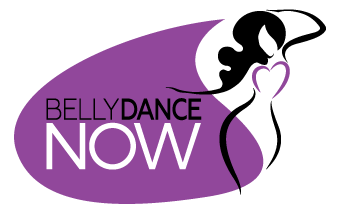The Administration Jungle
October 18th, 2021JWAAD hosted a free networking morning for bellydance teachers on Saturday 16th October. It was so useful we are adding each of the speakers and their subjects on separate blogs. Sign up for our emails if you want to be notified of the next one.
Here is Dorte Evelyn having a look at the intricacies of PPL, PRS and insurance options.
Part of a free day designed as a bellydance teachers networking event. Hosted by JWAAD and Kay Taylor. Sponsored by the JTA. (JWAAD Teachers association).
If you would like to join the JWAAD teaching community, develop your confidence as a teacher and give your students more confidence in you, the next ‘Bellydance Safely‘ course taking place on Zoom might be of interest. Dorte also teaches on this course.
Yasminas Top 5 Songs
October 4th, 2021By Yasmina of Cairo
The first Arabic music that ever impacted on my consciousness was a lush, melodious song by Farid el Attrache, ‘El Rabeih’ (Spring), which I heard, not in Egypt, but Morocco, when I was on holiday there as a photography student in the 1980’s. Wandering through the market place of Marrakesh, or listening to the radio while traveling by car, Egyptian music and songs formed the soundtrack to that holiday. Why not Moroccan music? Because Egypt has been exporting music across the Arab world from the earliest days of recording, and all Arab-speaking countries, from North Africa to the Arabian Gulf and the Levant, have absorbed Egypt’s musical legacy. Before leaving Morocco, I stocked up on a whole bag of audio cassettes and took them back to London, where I played them non-stop while driving, at home, and in my photographic studio with bemused fashion models wondering why I wasn’t listening to Depeche Mode or the Human League instead.
Of course at the time I had no idea of the origin of the music. Farid el Attrache meant nothing to me, nor Oum Kulthoum, nor Abdel Halim Hafez. My education began when I started taking belly dance classes and began to learn movements to interpret the music I was already in love with. Early on I was also directed to the world of early Egyptian cinema, which I instantly adored. Already a Hollywood classic movie buff, it was a joy to me to discover a parallel film world with so many of the same elements, but accompanied by all these wonderful new sounds.
Listening to ‘El Rabeih’ now, I still get a flash of that original feeling, and in hindsight I can analyze what it was that drew me. Farid el Attrache was a prolific composer and wrote his 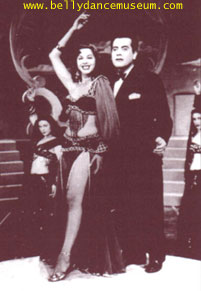 own songs, as well as those of other artists that performed in the films he starred in. The 1949 ‘Afrita Hanem’, which features ‘El Rabieh’ as a lavish set piece with Samia Gamal and a chorus of back-up dancers, was one of the most iconic musicals of the period. The closing theme is a waltz, something easily accessible to the Western ear. But also that lilting melody, the lushness of the violins – it all carried me away in a swooping wave towards the ‘otherness’ of this new world I was being seduced by.
own songs, as well as those of other artists that performed in the films he starred in. The 1949 ‘Afrita Hanem’, which features ‘El Rabieh’ as a lavish set piece with Samia Gamal and a chorus of back-up dancers, was one of the most iconic musicals of the period. The closing theme is a waltz, something easily accessible to the Western ear. But also that lilting melody, the lushness of the violins – it all carried me away in a swooping wave towards the ‘otherness’ of this new world I was being seduced by.
Many dancers I know have spoken of their first musical crushes in their journey into Egyptian dance. I strongly believe that if you don’t truly love the music, you will never achieve your potential as a dancer. Because belly dance is also basically a solo dance (group numbers not withstanding), that fortunately means you can indulge in your own personal tastes on stage. You can make your own choices – even when dancing to live music – and let that passion for the song bring strength and emotion to your performance. Also, since Egyptian music covers such a wide range of styles, different aspects of your personality and technical abilities can be explored by using contrasting choices. Feeling soulful? A classic piece by Oum Kulthoum, or something quiet and moody by Sherine, will help you express it. Feeling earthy and a bit exhibitionist? A shaabi or maharaganat song could be just the thing. Or if you are wanting to go deep into a complex range of technique, show off with a spectacular mejancee!
Exploring and internalizing different styles of Egyptian music takes time, and trying to negotiate your way through lists of names without being able to put them in any context can be bewildering. Physically living within the culture of the music – in Egypt – obviously made this process easier for me, and in fact my education was organic, in that I learned about songs, singers and musical history, through performing to live music. I let my band suggest things to me. I’d listen to them rehearse, then go away and find the original source of that music, in a movie, or on a cassette, to gain some context. Often the movie clip would influence how I would perform it. I learned which songs were considered good choices for dancers to use on stage, and which were avoided. I remember getting my musicians to rehearse Oum Kulthoum’s ‘Leylet Hob’ (Night of Love) which they did without their normal enthusiasm, and then performing it, only to be told disparagingly by another dancer that ‘it’s just one of those songs that doesn’t work for the audience.’ Until this day I haven’t been able to figure out why; perhaps it is just down to trends.
It is worth noting that since the 1990’s when I first began performing in Cairo, those choices have really changed a lot. A song such as ‘Befaker fe el Nasini’ (I Remember Those that Forgot Me), by Mohamed Abdel Wahab, was considered a singer’s song, not a dancer’s. Yet ten or fifteen years later it was seized upon as a party piece by a new generation, and I myself recorded it on a dance album (‘El Warda’). Anything with a waltz in it (such as my first inspiration ‘El Rabieh’) was a non-starter – and to be honest even now, the waltz is not considered a dancer’s rhythm in Egypt. But nowadays these ‘rules’ or trends have largely been tossed aside, partly due to more and more dancers trawling through back catalogues of lesser-used songs for something different. Even I was quite surprised when Safaa Farid (who has sung on the albums of numerous dancers producing dance versions of classics) recorded ‘Rissela min Taht el Maya’ (Message from Under the Sea), for Karim Gad, an Egyptian dancer living in France. It’s an Abdel Halim Hafez classic never used by dancers until now.
In my opinion, use of some of these highly complex but not always obvious choices of songs by dancers today, reflects an increasingly sophisticated embracing of dance technique. To interpret a musically complex song with multiple rhythm structures and lyrical content, you need a lot of experience and great confidence in your ability! Across the globe, dancers from many disciplines who have fallen in love with Egyptian style, are bringing their own strengths to bear in this regard. Performing to sophisticated and challenging music is an exhilarating way to show off your talent.
Of course the advantage of re-recording classic songs with dance in mind is producing them accordingly – for example adding a tabla when there was once only a req, and making the tabla more prominent generally. Or shortening really long classics with different sections into manageable lengths with just the sections you want. BUT – and I say this as someone who has produced seven full CD’s, including many original commissioned tracks, for belly dancers – it is also really important that dancers wanting to know their way around Egyptian singers and composers, listen to the originals. As belly dance music producers, most of us have a limited budget, and producing the kind of full orchestral sound that was used to record most of the classics is way too expensive. This is not so important when you re-record a baladi track, but it makes a huge difference when you try to recreate a piece by Baligh Hamdi or Mohamed Abdel Wahab.
The ‘Singers and Composers for Belly Dance’ course on the JWAAD Teachable site is designed specifically for dancers to learn their way around a contextual understanding of the kind of original music used in belly dance. It covers a broad range of styles, and attempts to put them in structural framework chronologically, and laterally, so you can see the progression in classical, shaabi and folkloric over the last century.
As a bit of a teaser to give an insight into the course, I’ve chosen five of my all-time favourite tracks (in no particular order) that have had an impact on my personal belly dance journey. All of them feature singers and/or composers that are listed in our compilation. Of course when I was coming up with the list I realized there are bound to be other peoples’ personal favourites that slipped between the cracks. So the list is not definitive, but one thing is sure: any dancer acquainted with the majority of these artists named in the course, will be able to consider themselves knowledgeable about the range, history and influence of music from the Arab world on belly dancers.
YASMINA’S TOP FIVE
1) Es-el Rouhak (Ask Your Soul) Composed by Mohamed Abdel Wahab, sung by Oum Kulsoum
When I first came to Egypt, I believed myself somewhat acquainted with the most famous songs of Oum Kulthoum. I had performed versions of some of them (Leylet Hob as mentioned above, Inta Omri, Ana Fintizarek and others) on CD and with house bands in different countries for years. But this one, Eshel Ruhak, seemed new to me, and I was blown away by the sheer drama of it. Perhaps it arrived to my ears at a time that I was responding emotionally to the whole experience of where I was and who I was with, and the heart-stopping weeping of the violin solo gave me goose-bumps. To me this song carves a direct route to some of the most emotive aspects of Egyptian music. It is composed mostly in the hogaz maqam (or key), which is famous in Egypt as it is also the maqam of the Adan, or call to prayer. Rising from a low note, it conjures a feeling of building dread somehow. And when I learned the meaning of the lyrics I began the process of integrating the emotion of the music with something tangible in the emotion of the words.
Your betrayal of me affected me
And I changed bit by bit
I changed, and it wasn’t in my hands (i.e. I had no control over it)
And I began to bury my tenderness for you
And hate my weakness and patience for you
And I chose to go far (from you), and became stubborn
I was even able to desert you
And you, oh my darling
If you were in my place,
What would you have done differently?
Ask your soul
2) Ahwaak (I Adore You) Composed by Mohamed Abdel Wahab, sung by Abdel Halim Hafez
This is the ultimate dreamy love song that begins in classic movie mode at a grand piano,  wafts you away on a melting cushion of oriental rumba, before lifting sharply into a dramatic rhythm shift and a soar of violins. A classic composition of Mohamed Abdel Wahab (you can learn more about his important contribution to Egyptian music in the course), it switches from the western to the Arabic scale halfway through, and is a great example of Abdel Wahab’s embracing of western orchestral music. The second half of the song builds slowly, gaining tension until it gives again, returning to the western scale and easing back into a soft ending. This is a wonderful song to just listen to, though when the oriental rhythms begin I defy you to stay still in your seat!
wafts you away on a melting cushion of oriental rumba, before lifting sharply into a dramatic rhythm shift and a soar of violins. A classic composition of Mohamed Abdel Wahab (you can learn more about his important contribution to Egyptian music in the course), it switches from the western to the Arabic scale halfway through, and is a great example of Abdel Wahab’s embracing of western orchestral music. The second half of the song builds slowly, gaining tension until it gives again, returning to the western scale and easing back into a soft ending. This is a wonderful song to just listen to, though when the oriental rhythms begin I defy you to stay still in your seat!
I loved this song so much I not only re-recorded it, but also featured it in a stage show (Spirit of Egypt) in both the UK and South Africa (2013), with a group of ballroom dancers paring up to interpret the rumba.
3) Kitab Hayati (The Book of My Life) Composed by Yousef Taaha, Sung by Hassan Asmar
Picture the scene: four am in a Cairo cabaret, the air dense with shisha smoke and customers waving their whisky glasses in time to the slow beat of the mazhab – some of them moved to step onto the stage and sway, others letting themselves fall into the sentiment of the lyrics, a charged mix of tragedy and excitement.
‘The book of my life, I’ve never seen a book like it. There are two lines of joy, and the rest is suffering!’ To deliver this brilliant shaabi lyric requires a classic shaabi voice: rough, powerful and with a break and a catch in it that heaps on the pathos.
This song for me captures the feel of live shaabi at its best, and Hassan Asmar, like Ahmed Adaweya, was a king of shaabi, but rightly or wrongly it was my impression that while Adaweya was a showman, Hassan Asmar had more gravitas. In contemporary Cairo, Ahmed Sheba, singer of the recent hit ‘Law La-ebt el Zahr’ (What if the Dice were Rolled ) is a natural descendent of this style of shaabi, and it is interesting to compare the two. ‘Kitab Hayati’ has been covered by many shaabi singers, but also by Lebanese star Georges Wasoof, whose gravelly voice (roughened, some say, by cocaine) was a perfect match.
Structurally I love the way the song begins with a killer vocal mawal, moves into a deep masmoodi, and then suddenly, just when you are immersed in that mesmeric rhythm, stops and kicks into a really fast maksoum, upping not just the tempo but the whole feel of the song, like a car that shifts gear and shoots down a race track. This is shaabi at its best for me; dark, melodically bluesy but exciting at the same time.
4) Maoula Di (Is this Possible?) sung by Shafika.
A new documentary that came out in early 2021 looks at the legacy of Shafika, referred to as the Oum Kulthoum of the Delta. Yet she is relatively unknown by the belly dance community, and even by many younger Egyptians. Very much a star in the rural shaabi communities of towns like Tanta and Mounira, she dominated the world of provincial baladi weddings until her death in 2011. When I first heard the song Maoula Di I was amazed at its rich musical arrangement – nothing like the kind of shaabi I’d been aware of until then. And that was when I began to understand that shaabi music could be complex, layered and sophisticated. I decided to record Ma-oula Di on my last CD, which was aptly named ‘Hayati’ (My Life) because I put on it many of the songs I’d most loved during my time on stage in Egypt. But actually it was a song I wish I’d used in my shows but never did. The original has such rich instrumentation that many workshop students have not identified it as shaabi at all. But you really only need to hear one note of Shafika’s voice (one that was hard to replicate with another singer) to identify its pure shaabi roots.
stage in Egypt. But actually it was a song I wish I’d used in my shows but never did. The original has such rich instrumentation that many workshop students have not identified it as shaabi at all. But you really only need to hear one note of Shafika’s voice (one that was hard to replicate with another singer) to identify its pure shaabi roots.
I also love the unequivocal lyrics which express disbelief at the fact that a lover has betrayed you and gone off with someone else. Its sense of outrage and hurt is so well expressed.
5) Fi Yum w’Leyla (In a Day and One Night) Composed by Beligh Hamdi, sung by Warda
Although some might cite Batwan Nasbeek as their favourite Warda track to dance to, Fi Yum w’Leyla is my choice. I listened to it quite indifferently for a long time when played by various bands, perhaps because it was over-used. And then, late in the day, I decided to play the whole of the original, the second and third parts of which are often missed out by dancers on stage. I was in love, and have recently used it – insisting on including those parts, which some musicians need to reacquaint themselves with. One thing I love about the old Warda classics is the seventies orchestration with its now vintage guitar sound. While during the eighties and nineties it seemed dated, to me it’s moved to the ‘classic’ stage. I think it would be quite difficult to recreate that sound now – certainly with a pared down oriental orchestra. But I particularly like the way you can shimmy to the electric guitar!
6) Tamally Ma-aak (I Am Always With You) Released 2000, Composed by Sherif Teg, Sung by Amr Diab
I am adding this as a postscript to my favourites list, even though is really isn’t a belly dance track. One of the biggest hits of the Arab world from arguably still its biggest pop star, it stands the test of time as a pop classic. It has a gorgeous melody and irresistible Spanish guitar – at the time a relatively new feature in Egyptian pop introduced by music composer and producer, Hamid el Shaeri (someone you can learn more about in the Course).This song was actually produced though by another star-making name in Egypt, Tarek Madkour. And of course it features the honeyed tones of Amr Diab, whose name and standing still towers above many newer successful singers in Egypt. Tamally Ma-aak uses a western scale, which makes it accessible to international audiences. A borderless crowd-pleaser, it’s a track for relaxing and unwinding – also great to play while driving in a warm climate with the wind in your hair!
You can subscribe to this course individually – or to our bellydance bundle ‘Bellydance Music Explored’. An in depth and fascinating musical journey.
Yasmina is not only one of our directors but has worked professionally as a dancer in Cairo for many years and understands the context of the dance and music. She teaches workshops on the international circuit and has a dancers BnB in Cairo. Yasmina brings a depth of knowledge to all her work.
Isolation is an Illusion
September 13th, 2021
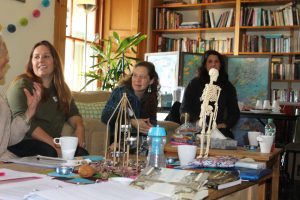
Anatomy discussed
One of my favourite parts of teaching the Anatomy in the JWAAD safety course is when we start looking at analysis of movement. This is the exploration of which muscle (and joints) are involved in executing different moves and how to teach that. One of the reasons I love it so much is that I too learn things from the sharing part which make me a better dance teacher.
Another aspect of the ‘active’ and ‘passive’ movements, specifically in isolation techniques is the body’s natural way to counter balance. This prevents us from falling when we move a certain body part out of the centre line. To someone
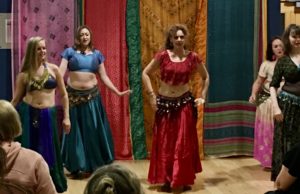
Galit and her girls
watching, the move (say a hip circle) will appear isolated. But the person performing it will notice that the upper body is also moving to maintain balance and poise. The counter balance of the body happens with every move that we make, including walking. I personally find it fascinating.
____________________________________
We are inviting applications for an ‘Yvette Cowles Scholarship’ – the last date for submitting them is 30th September. This award is specifically for people who want to do our ‘Bellydance Safely’ course. You can get up to 50% towards the course costs.
G to this link: ‘Yvette Cowles Scholarship’
Five Top Mistakes to Avoid
July 27th, 2021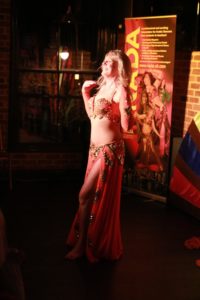 Written by Kay Taylor, managing director of JWAAD. Kay is one of the UK’s top teachers and has taught at most of the UK festivals as well as teaching internationally. Kay imports and sells costumes as Farida Dance – and runs specialist bellydance holidays as Farida Adventures.
Written by Kay Taylor, managing director of JWAAD. Kay is one of the UK’s top teachers and has taught at most of the UK festivals as well as teaching internationally. Kay imports and sells costumes as Farida Dance – and runs specialist bellydance holidays as Farida Adventures.
We all make mistakes through our lives ….. move on from them ….. and hopefully learn from them. These are the top five mistakes I have observed dancers make. Some are or have been my students, others I have discussed this with at events and courses over the years. Having taught bellydance for over 30 years and made my living from it as a teacher, promoter and vendor, I have a wide network of bellydance friends around the UK and internationally. A huge knowledge base to draw from.
Mistakes can lead to stagnation, disillusionment, burn out or losing your mojo.
1/ Doing too much too soon
Over enthusiasm can lead to burn out. It is all about getting the right balance which will be different for each person. Through the pandemic some dancers signed up to hundreds of things on Zoom then found it was all too much and stopped dancing entirely.
Even before the pandemic I spotted two trends. First, the very enthusiastic new student who throws themselves at it, are upset when they can’t do it straight away and give up. Second the student who sticks with it and suddenly finds the wider dance world, starts travelling to lots of things, over commits themselves, gets exhausted and gives up because what they are doing is unsustainable.
Pick and choose what is right for you. What is right for your development at that particular time. If you are not sure, ask your teacher what they would suggest or if you don’t have a regular teacher find a mentor to help point you in the right direction.
2/ Stop going to classes
There are lots of reasons people might stop going to classes. A pandemic being one of them …. or maybe your life just got really busy …. or maybe you feel your regular class is no longer challenging enough. In the UK lockdown is lifting and classes are starting back up again. Times, venues and days may have changed so check your local ones out and commit to the one that best fits your schedule. When life gets busy and we start missing classes it is easy to get out of the habit of going. Decide what is important and prioritise your time. If the class is no longer challenging enough consider asking the teacher for private lessons to give you something to work on.
The problem with not going to regular classes is that we can develop bad habits and we loose our connection with the dance community and can lose your dance mojo. Classes are a place to immerse ourselves in bellydance music and moves, work on technique, develop improvisational skills and have fun with our belly buddies and get new inspiration. Regular classes are an important foundation to help feed our passion for bellydance…. it never hurts to go back to basics even if your class doesn’t challenge you any more.
If you are in an area where there is no local teacher, look at the Zoom options. These days you can join a class from anywhere. Or find a teacher/mentor you can go to monthly to keep you on track.
You can develop further by going to workshops and festivals or having private lessons. You can also develop your knowledge of the dance by doing courses like the JWAAD courses in music or culture. This informs your dance in a completely different way.
3/ Too much focus on technique
Technique is important but we can get too focused on it. If you only focus on improving your technique or adding new moves to your repertoire this can lead to disillusionment. Maybe we do not progress as quickly as we wanted to ….. there is that one move that you can’t quite crack no matter how hard you practice. Stop. Remember why you fell in love with the dance. Was it the music or the camaraderie? Was it the joy of moving your body in a new way?
Sometimes you have to move away from technique and just remember the joy of dancing for fun. Also  by moving away from it, you give your body chance to absorb it in a different way and then when you go back to it, you may find it suddenly clicks.
by moving away from it, you give your body chance to absorb it in a different way and then when you go back to it, you may find it suddenly clicks.
Our bodies are all different and can do different things. You do not have to have a wide repertoire if you do what you do well! Best to do a smaller amount effectively than too much that ends up being unrecognisable. Play to your strengths and find what moves your body has an affinity with.
No one ever watches a dancer and is inspired by their technique. The technique is a given, the musicality, emotional expression and personality are what inspires.
Having said all this, of course technique is important and the top dancers have excellent technique on top of all the other qualities needed to be a star!
4/ Staying in your comfort zone
We are all guilty of this at some point. There is nothing wrong with having a comfort zone and staying within it most of the time but you do need to push the boundaries if you want to develop otherwise you risk stagnating. It is easy to keep doing what you do. And if you are happy with that, stick with it. Many of my weekly students are happy doing what they do. I give them enough to push them slightly along with a core of familiar moves. I am constantly surprised when I suggest someone moves to the next level class how many people do not want to. Maybe because they have a core of friends within their current class – or because it feels too much out of their comfort zone. Maybe some take up the challenge eventually, other really are happy staying where they are – and others fall by the wayside. Not ready to move forwards but dissatisfied where you are? Take the challenge!!
If there isn’t a higher level class, go to workshops or festivals to top up your learning.
5/ Teaching too early
I have encouraged many dancers over the years to start their own classes. I love the idea of local classes so that everyone has access to a class wherever they are. Having taught the JWAAD safety course for a long time I have talked with both new and experienced teachers who have studied with us.
As a teacher it is easy to run out of inspiration or to keep giving until there is nothing left. You have to continue your own dance journey as well as teaching your class. You owe it to your students to be the best teacher you can be.
Some rush into teaching too soon and find the responsibility of teaching a regular class too much and give up both their classes and their dance. Others neglect their own development so their classes become very similar and eventually students get bored and leave.
If you have a full time job and possibly family commitments, it can be difficult to balance everything.
So, much as I would love classes to spring up everywhere, think about it. How much do you know and what commitment can you give to a class? Remember it is not just about teaching a fun pop choreography …. do you know the meaning of the song? What rhythms and styles are within it? What can you tell your students about it to help them understand. How developed is your technique and do you have a wide enough repertoire with which to teach?
what commitment can you give to a class? Remember it is not just about teaching a fun pop choreography …. do you know the meaning of the song? What rhythms and styles are within it? What can you tell your students about it to help them understand. How developed is your technique and do you have a wide enough repertoire with which to teach?
All things to think about. Better to keep passionate about bellydance … and keep loving what you do than start teaching too early and loose your love of it.
Some of these may resonate with you. Each of us is different and we have to find our own path. Whatever you do, keep dancing!
Below are some options you can take up with JWAAD. These are suggestions – there are many other things out there in the wider dance world too.
Personal Development Programme
Private lessons with one of our JWAAD mentors who assess your technique and suggests ways to develop your dance. You can build a great relationship with your mentor who can help direct your learning to work towards what you want to achieve.
Our online music courses make up a whole musical journey. Sign up to the bellydance bundle ‘Bellydance Music Explored’ to immerse yourself in and learn about all aspects of music. You can dip in and out when you have time. There is a supporting facebook group and live lectures on Zoom.
In depth and fascinating. This is an investment. It covers everything from safety and lesson planning to background knowledge including music and culture as well as teaching skills. It takes a couple of years to complete and is split into modules.
5 tips for teaching effectively via Zoom
July 21st, 2021By international dancer, performer and movement expert Dorte Evelyn, founder of the Ishtar Dance 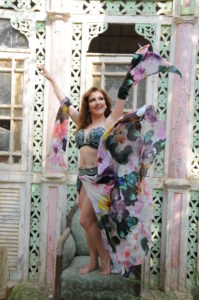 Academy.
Academy.
For more than 3 years leading up to the Corona pandemic, I was teaching online using Zoom as well as other online platforms, so I guess I was prepared for the lockdown and everything that followed. But I still decided to make some changes to ensure my online classes were taught in an effective and professional way.
We now also teach this as part of our Bellydance Safely course which has an entire module dedicated to Zoom; how to use, how to troubleshoot, and not least how to use it in a way that still allows you as a teacher to check your students progress, and your students to enjoy and learn from the session too.
Why is this needed?
Teaching online requires different skills, and classes and workshops often need to be structured differently too. Many will have encountered and probably also [by now] resolved the sound issues that occur when you try to talk over the music. But there can still be problems with lag and not being in time with the music.
Why may you want to know all this as the world returns to ‘normal’? Because we have all moved on, and online classes are here to stay. They give students as well as teachers, the opportunity to teach beyond their locality. The convenience of not having to leave your house is – believe it or not – still a big selling point for some, and it gives the flexibility to be working and delivering classes even when you’re on the road. I will for example be teaching workshops from abroad this year via zoom and should I have to self-isolate or strand somewhere, then I will still be able to run these.
So what are the key basics to remember when using zoom…
1 Get your connection right
You can’t help students who may live in an area where there isn’t broadband, but you can ensure that you have the best possible connection your end to enable the best possible user experience.
Wi-fi can vary, so where possible I always recommend investing in an Ethernet cable [£5-£20] that you can plug into your computer for the most stable connection possible. If this isn’t possible, then make sure you are as close to your wi-fi as possible and that no one else if using is for high-intensity stuff such as gaming or streaming when you need it.
As with all electrical devices restarting your wi-fi hub is good practice too, which can help overcome a sluggish connection.
 2 Help your students get set up
2 Help your students get set up
Even after several years of zoom meetings you would think that the entire world has become zoom super users, but that is not necessarily the case. So make sure you help your students get the set up right at their end too.
You can either pull a guide together for them ahead of your session, or you can spend 10-15 minutes going through how it works with them before your class starts.
Here it is user end tips that matter; how to switch the views, what to do if the connection goes, what to do if there is a lag and image and sound get out of sync etc.
Do also spend a few minutes get your students set up in their dance space to ensure it’s safe, well-lit, that you can see them clearly etc.
3 Get the sound right
Make sure to do a sound test before your class, so your students can feedback and you can all proceed with confidence.
Whether you have a mixer set up, or are relying on the suppression of background noise on zoom – it’s always worth muting your participants and then do some counting over the music to see if everyone can hear you ok and that that there are no timing or other issues with the sound.
There are hundreds of YouTube tutorials on how to get the set up right, so you can find all this for free online. We also spend quite a bit of time on how to set this up and test it during our Safety Course, as it’s through the practical application of this that you learn and gain the confidence needed to assist your students too.
4 Get your set up right
This includes everything from background, lighting, and even to what you wear! A distracting background can make it really difficult to see and follow moves, and distracting shadows don’t help either. Again, there are plenty of free YouTube tutorials to get you started or to improve your existing setup.
Make sure to have portable lights at hand, especially if you teach during different times of the day. And keep your clothing bright or colorful so moves show more easily to your students.
Make sure you test your set up if possible before the class starts either by doing a recording or simply by asking the first student that enters your virtual classroom.
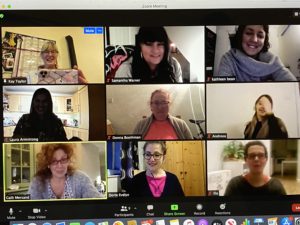
Zoom Safety course with Dorte & Galit
5 Adapting your teaching skills for online
So everything is set and you’re ready to start teaching – but have you structured your lesson to work for the online medium? Online teaching requires different skills than normal face-to-face teaching but everyone can learn it.
Communication is key, as is showing moves and combinations from different angles, because learning in 2-D is a lot harder than if you’re in the room.
Encourage your students to ask questions, and make sure that you take the time to monitor their progress and to feedback. If their setup isn’t great, then this may be tricky, which is why it’s important to take the time to get point 2 right.
Mirroring moves is obviously an essential skill for Zoom as well as the dance studio, but you also need to be mindful of how you structure your class, as people’s attention span often is lower when learning online. Keeping combinations simpler or building them up in a more structured way will help your students learn and not least enjoy the class more.
And finally, don’t forget to ask for feedback from your students too. Teaching via a screen can sometimes become/feel one-sided, so use the time on either side of your lesson to engage with your students and find out what worked and what needs improving.
We never finish learning, and this is very much the ethos of JWAAD too, and why I enjoy delivering courses such as the Bellydance Safely course – also online. To go direct to book your place on our next course starting on 13/14th November click here.
To find out more about Dorte visit the Ishtar Dance website: www.ishtardance.com
Amazing music workshops …..
May 13th, 2021We are delighted to announce a range of new lectures and workshops to run alongside our online course launched in 2020 ‘Bellydance Music Explored’.
‘Bellydance Music Explored’ replaces our previous ‘Understanding music used in bellydance’ course. It includes all the previous information and has been updated and refreshed with current and relevant clips, interviews and links.
‘Bellydance Music Explored’ is a bundle of six courses which you can work through in your own time. You have access for 12 months. There are 6 new lectures each year to accompany the course. These are free to subscribers and held via Zoom. They are recorded and added to the relevant courses so you can access them even if you didn’t join the live lecture.
Our next lecture is with Abeer Will who studied with a folklore troupe at university in Egypt. She fell in love with all styles of bellydance. She met her husband to be whilst touring with the troupe in Germany and he persuaded her to marry him and move there where she still lives. Abeer was going to join us at Summer School last year but of course Covid put stop to that!
fell in love with all styles of bellydance. She met her husband to be whilst touring with the troupe in Germany and he persuaded her to marry him and move there where she still lives. Abeer was going to join us at Summer School last year but of course Covid put stop to that!
Sunday 27th June 2021
‘Recognising Baladi Music’ 2 – 3pm UK time
In this lecture, Abeer will look at the different types of music classified as baladi including Tet Baladi and Baladi Awady. She will explore what makes them baladi and help you recognise what baladi is. This is free to dancers who subscribe to ‘Bellydance Music Explored’. For those who do not subscribe, you can pay to join the live Zoom lecture but won’t have access after the event. Click on this link to book.
We also host workshops to run alongside ‘Bellydance Music Explored’. These are open to all  dancers though we do limit numbers and subscribers get priority booking. The content helps consolidate information in the course and we often recommend you have completed specific sections to get the most from them.
dancers though we do limit numbers and subscribers get priority booking. The content helps consolidate information in the course and we often recommend you have completed specific sections to get the most from them.
Sunday 13th June 2021 4 – 6pm UK time
Zoomtastic Tabla Solos with Yasmina of Cairo and Joelle Barker
An amazing opportunity to study tabla solos with Yasmina. She will share her Cairo experiences of working with live music and help you develop your own tabla solo with Joelle. Numbers are limited to ensure you all get the opportunity to develop your Zoomtastic Tabla Solo so book early here
Joelle is holding a class to play rhythms before the tabla solo class. As a dancer this really helps you access rhythms in a different way. Contact Joelle direct to take part – this is her FB page.
Sunday 27th June 2021 3.30 – 5.30 UK time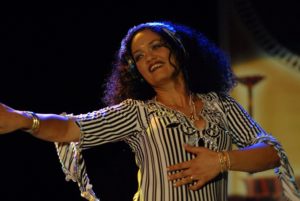
Build an improvised Baladi dance to Baladi Awady music with Abeer Will
This dance workshop builds on the earlier lecture. Abeer is a very generous teacher and shares music sources as well as information. Abeer will explain the structure of Baladi Awady, the feeling and what it is important that you catch within the music. This will enable you to bring a really authentic feel to your dance. Click here to book.
If you want to join our amazing musical journey and sign up for ‘Bellydance Music Explored’ click here.
For us at JWAAD the music is such an important part of bellydance. There are so many different genres of music, different rhythms and styles. Understanding them informs your dance in a completely different way. It gives you confidence and inspires you to add more range and depth to your dance.
Whatever dance journey you choose, we hope you enjoy it and keep developing your dance.
Getting to know: Claire Barnfather
September 30th, 2019Though Claire studied with me for years, she has gone onto develop her own style – both as a bellydancer and as a bellydance teacher. I love teaching the accredited courses with Claire – her teaching is so clear and concise. She pulls out the best from people and identifies things that really help their dance.
I love watching Claire perform – especially an emotional piece – she makes you cry …. in a good way! – Kay
Tell us a bit about your dance journey – how did a geologist get into bellydance?
I got into bellydancing when I was doing my MSc at Durham Universit and was looking for something different to do other than a fitness class. I stumbled across the university Bellydance Society being taught by the lovely Oona Leppington and it didn’t take long before I was hooked. On moving to Newcastle I was lucky enough to discover Kay Taylor’s classes. Her teaching was an inspiration for me, and her support unwaivering. I had always been “the shy one”, and nothing could ever have been further from my mind than performing in public. Yet, with Kay’s encouragement, I got to the stage where I could not only get up there, but I could actually enjoy performing and sharing my love of  dancing with people. Since then I have had some fantastic experiences through dancing…being part of the Tarab Dance Company, performing on stage at the Edinburgh Fringe, Glastonbury Festival and in Algeria, learning to dance in Cairo and meeting the most incredible people. I remember my dad rolling his eyes at my latest hobby when I bought my (first) hip belt…I don’t think either of us would ever have guessed how it would take over my life for the next 20 years!
dancing with people. Since then I have had some fantastic experiences through dancing…being part of the Tarab Dance Company, performing on stage at the Edinburgh Fringe, Glastonbury Festival and in Algeria, learning to dance in Cairo and meeting the most incredible people. I remember my dad rolling his eyes at my latest hobby when I bought my (first) hip belt…I don’t think either of us would ever have guessed how it would take over my life for the next 20 years!
How did you start teaching? Tell us a bit about your teaching journey.
I started teaching occasionally about 15 years ago to help provide cover when a local teacher was ill, before starting to teach my own regular classes. I did enjoy it, but the turning point in my teaching didn’t come until after I’d been  teaching several years and decided to do the JWAAD Teaching Diploma. The background knowledge it gave me was invaluable, but it did more. It opened my eyes and gave me the tools to develop my own distinct teaching style; which focuses on experiencing the music, developing body awareness and encouraging students to be themselves and develop their own unique style. Knowing how the JWAAD Diploma changed the way I look at both teaching and my own dancing, I’m really proud to currently be part of the teaching team on JWAAD’s accredited courses. I love the moment (which seems to happen whenever I get to teach on one of the courses) when I see something click for one of the students and make them see what they do in a whole new way!
teaching several years and decided to do the JWAAD Teaching Diploma. The background knowledge it gave me was invaluable, but it did more. It opened my eyes and gave me the tools to develop my own distinct teaching style; which focuses on experiencing the music, developing body awareness and encouraging students to be themselves and develop their own unique style. Knowing how the JWAAD Diploma changed the way I look at both teaching and my own dancing, I’m really proud to currently be part of the teaching team on JWAAD’s accredited courses. I love the moment (which seems to happen whenever I get to teach on one of the courses) when I see something click for one of the students and make them see what they do in a whole new way!
Over the years I have found that I have a real knack for spotting those small changes that can make a big difference to a dancer, and as such absolutely love helping dancers  to develop one-to-one. For this reason I’ve run two “Leyl el Raqassa” performance projects; working over a summer with soloists of all levels to develop unique performances that help them develop their dance in new ways. The resulting shows have been fantastic, intimate, supportive events where the dancers have been able to take risks and really push their performances to a new level – I’m really hoping to be able to run one of these courses again soon! These shows have been some of my proudest moments in my entire dance career, alongside the absolute jaw-dropping surprise of receiving the 2017 NADA Glitter Award for Most Inspirational Teacher.
to develop one-to-one. For this reason I’ve run two “Leyl el Raqassa” performance projects; working over a summer with soloists of all levels to develop unique performances that help them develop their dance in new ways. The resulting shows have been fantastic, intimate, supportive events where the dancers have been able to take risks and really push their performances to a new level – I’m really hoping to be able to run one of these courses again soon! These shows have been some of my proudest moments in my entire dance career, alongside the absolute jaw-dropping surprise of receiving the 2017 NADA Glitter Award for Most Inspirational Teacher.
You have a young son – how do you manage to combine your day job and dancing and motherhood?
Bellydancing has been such a huge part of my life for so long that I was really shocked at just how tricky it can be to create both time and headspace to  dance in between juggling babies/toddlers and doing the day job. Having my son has given me so much respect for the job that mums do! What has kept me going during the tough times is the enthusiasm and love for the dance that my students have…I adore teaching them and they’re a constant reminder of the joy that dance can bring and why I love it so! If I ever feel exhausted before a class, I always leave buzzing. I find these days that I have to guard some time for myself, so my big tip to new mums would be to try to book some time and space away from the house to just really dance and blow the cobwebs away every now and again!
dance in between juggling babies/toddlers and doing the day job. Having my son has given me so much respect for the job that mums do! What has kept me going during the tough times is the enthusiasm and love for the dance that my students have…I adore teaching them and they’re a constant reminder of the joy that dance can bring and why I love it so! If I ever feel exhausted before a class, I always leave buzzing. I find these days that I have to guard some time for myself, so my big tip to new mums would be to try to book some time and space away from the house to just really dance and blow the cobwebs away every now and again!
What do you like to do to relax?
Nothing beats a walk along the sea front on a blustery day (maybe followed by a coffee or hot chocolate to warm up again).
What is your star sign?
Gemini
What is your favourite colour and why?
It varies – I like rich jewel colours: turquoise; the blues and greens of a peacock’s tail; 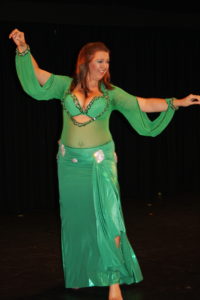 magenta and fuschia pinks; flame orange; and dairy milk purple. I don’t know why – these bold and beautiful colours just make me smile!
magenta and fuschia pinks; flame orange; and dairy milk purple. I don’t know why – these bold and beautiful colours just make me smile!
At Fantasia you are teaching ‘Dodo wings to dancers arms’ – can you tell us a bit about what to expect:
Arms and hands seem to cause trouble for many of us as dancers: sometimes they’re an afterthought to the rest of our dancing and we find them flapping around; sometimes they’re drilled into position so hard that they can feel and look dead and unnatural; or other times they occupy all too much of our headspace and distract us from the rest of our dancing. We’ll be looking at a few techniques and tricks you can take away and practice to improve arm and hand alignment and energy, develop good habits and build muscle memory of some helpful arm movements. Dramatic results are possible!
What does the dance world hold for you in the next 6 months?
My post-baby return to dance has been longer and harder than I had ever imagined it would be, and I have been developing my very own toolkit to help me get back into the swing of things… I’m hoping down the line that this is something I can share with other dancers coming back from a break! Now I’m back, I really want to make the most of and enjoy every moment of my dancing. So, for the next little while I’ll be dancing and going to events for my own pleasure; helping my students to develop and flourish; and plotting and planning for my next performance project!
Lastly, what would you like to be doing in 5 years time?
In 5 years’ time I’d like to be back teaching again more regularly, helping more and more dancers to reach their potential!
Getting to know: Moyra Banks
September 24th, 2019Moyra Banks aka The Scottish Bellydancer is based in Edinburgh where she teaches regular bellydance classes. I remember the first time she came on one of my Cairo trips – and bought a Sahar Okasha costume – the most expensive costumier in Cairo. More than 10 years later she still has it …… so it must have been worth it. Moyra now has a range of designer bellydance costumes: Eman Zaki and Hanan Mahmoud as well as her Sahar ones. As she performs regularly she does need them. She is probably the best dressed bellydancer in Scotland! – Kay
How did you get into belly dance?
As a teenager I saw my friends attend a bellydance class. I originally thought this was hilarious and wondered why on earth they would do such a thing. I then went to see them perform and I was hooked from then on. Something in the music and the costumes just resonated with me and I knew I had been missing out.
Tell us a bit about your dance journey – how did you end up teaching and performing
 Through my first teacher I began regularly performing in a local restaurant with other students. From there other performance opportunities arose and I have been performing at weddings, hen parties, restaurants and even a funeral or two ever since. I am lucky that the dance community is relatively small in Scotland so I know most of the other dancers.
Through my first teacher I began regularly performing in a local restaurant with other students. From there other performance opportunities arose and I have been performing at weddings, hen parties, restaurants and even a funeral or two ever since. I am lucky that the dance community is relatively small in Scotland so I know most of the other dancers.
In terms of teaching this came about as an opportunity when my teacher moved to Cairo. She passed on some classes to me and since then I have grown and developed my teaching including through completing the JWAAD teaching diploma. I am now training to teach the JWAAD accredited courses which I am very excited about.
What did you like most – and what did you like least – about teaching bellydance?
I love seeing my students develop and go from hiding at the back of the class to rocking it on stage. I love the development of the nerves and uncertainty before their first performance to being asked if they can dance again after it as they loved it so much.
Teaching certainly keeps you on your toes and developing so you’ve always got something to teach your students and sometimes you can doubt yourself which is definitely a downside to it.
I have become a JWAAD mentor and this has led to teaching more private lessons as I help folks progress with their dance. I love seeing the difference this makes – and it gives me more confidence that I am doing something right.
You are really busy with dance, a day job and being one of the principle dancers in the Helwa Dance Company – what does a normal week look like for you?

Moyra leaping off stage sha’abi style
I think it can be summed up in the word “busy”! I teach 2 to 3 nights per week and one night per week I am normally reminding myself of what is on the lesson plan that week. At the weekends I normally have at least one gig and there can also be full day Helwa rehearsal too and on occasions I try to squeeze in a lesson with Kay Taylor of Farida Dance. I am very excited about out upcoming Helwa tour – you can find details on www.helwa.uk
I am lucky that my day job is focused on outcomes and not hours and I have a really supportive manager. I can work from home when required so there are times when I may leave work in the middle of the day to dance and then log back on in the evening.
What do you like to do to relax?
I’ve recently started to focus back on my own health and wellbeing after realising I was always giving to my students and not taking time to myself. This involves early starts at my local gym doing a focused programme but it is great start to the day and helps me take time for me. I also love a spa day and on occasion I can be found at the local stables out on a hack. Normally though, due to time you can find me having a long soak in the bath with a good book.
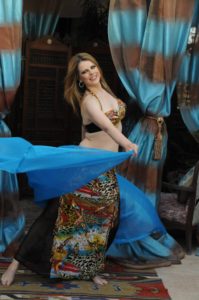
What is your star sign?
I am a Pisces and I love that this is associated with creativity and the arts. It is also known for being addictive which may explain why dance takes up most of my time…..
What is your favourite colour and why?
I wasn’t sure I had one but I’ve just checked my dance wardrobe and I think I will have to say green / blues. I just seem to be drawn to this and on reflection a lot of the ateliers seem to put me in these colours. There must be a reason for that!
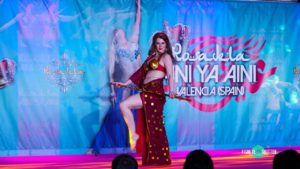
At Fantasia you are teaching ’Sassy Saidi’ – can you tell us a bit about what to expect:
I love Saidi. My aim is to deliver an upbeat and vibrant workshop and hopefully give people some new ideas to spice up their saidi. It’s a short workshop but we’ll look at some patterns and combinations. (You can see Moyra performing saidi at the Aini Ya Aini festival here.)
You are one of the team launching a new festival in Edinburgh: Alba Orientale. Tell us a bit about it.
I am really excited to be part of this festival. There’s something really special about being in Cairo and watching a dancer live, not everyone can get to Cairo so we’re bring a little bit of Cairo to Edinburgh. I am passionate about showing as many people as possible how amazing dance can be and encourage people to push themselves and try new styles and moves. This is an opportunity for people to have access to some of the most amazing teachers and styles. Find out more on www.albaorientale.com
Lastly, what would you like to be doing in 5 years time?
Hopefully a little less day job and some more dancing and teaching. I’d like to make some time to see some more of the world too.
To book your Fantasia day ticket click here.
Fantasia is Londons longest established bellydance festival. If you haven’t been to a Fantasia Bellydance Festival yet, now is the time!
